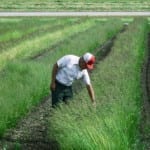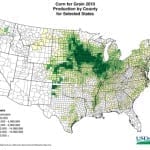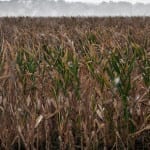Drought spurs moderate crop insurance payouts this year The ongoing drought that has gripped much of the U.S. may not be as economically calamitous as had been predicted, according to insurance payouts to farmers in some of the most drought-stricken states. Earlier this year, farmers had expected to lose the vast majority of their produce due to severe drought. While the drought proved to be one of the worst the country has experienced in its history, spurring the federal government to purchase stocks of fish and produce, the economic impact…
Read MoreTag: us drought
Crop insurance payouts may break double the previous record
Some estimates have claimed that the payments will be greater than $25 billion. After crunching the numbers for this year’s crop insurance payments, it looks as though this coverage – which has been vital to farmers this year due to the widespread droughts and floods – it looks as though the payouts will be greater than $25 billion. This will be over twice the $10.8 billion record high that was set in 2011. This year, over 80 percent of the corn fields had crop insurance coverage. Clearly, this was significantly…
Read MoreCrop insurance in the US braces for costly impact
Crop insurance payouts could be a costly issue The U.S. has been battered by an extensive and severe drought that has destroyed farmlands throughout much of the country. The drought has been a significant problem for some time and has been at the center of arguments and legislative action concerning the issue of crop insurance. Even before the drought took hold of the country, crop insurance was a hot issue. Now, the economic impact of insurance payouts that many have feared are becoming a reality. Analysts suggest insurance payouts could…
Read MoreCrop insurance in Midwest is increasingly strained
The losses from these claims are continuing to grow in the Corn Belt. After a growing season that has already led to exceptionally high crop insurance losses as a result of droughts, the temperatures in the triple digits are now sending a new wave of claims through the Corn Belt, with record losses being predicted by experts in the industry. This problem has been made worse by the changes that decreased the premiums of some growers. It has been estimated that the crop insurance losses will reach almost $15 billion…
Read MoreMaryland aims to promote crop insurance through new initiative
Department of Agriculture to educate farmers on crop insurance The Maryland Department of Agriculture has taken an aggressive stance in promoting crop insurance. The severe drought that has gripped the U.S. has caused unprecedented damage to crops throughout many states. There are no signs that the drought will abate any time soon, leading government officials to tout the protection that could be provided through crop insurance. Maryland officials have embarked on a mission to educate local farmers on the protections they can receive through appropriate coverage. Ongoing drought draws attention…
Read MoreCrop insurance comes under fire in the midst of U.S. drought
Drought highlights the controversy surrounding crop insurance The worst drought in 60 years has established a stranglehold in the U.S. The severity and persistence of the disaster is threatening to cause widespread food shortage as the country’s corn and soybean crops begin to suffer. The onset of the drought has brought attention to the country’s crop insurance program. The program was initially formed as a way to provide farmers with the protection they needed but has been subjected to several changes throughout its existence. Now, concerns are rising over the…
Read MoreNM cattle ranchers battle new federal drought protection policy
Cattle ranchers in New Mexico are up in arms over a new federal insurance policy that they purchased under the belief that it would provide them with drought protection, but that isn’t helping them because satellites are reporting that there is still too much “greenness” in the state. The primary problem is that there isn’t any grass for the livestock to consume. In fact, this year the conditions are so devastating that cattle ranchers have been selling their animals in record numbers because they can’t afford to purchase their feed.…
Read More





